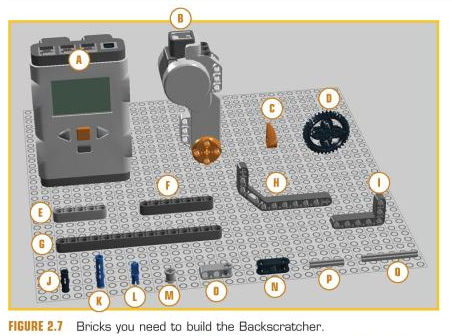| Basic Robot Building With LEGO Mindstorms NXT 2.0 |
|
Author: John Baichtal Getting started with building and programming robots requires a lot of different skills - even if you take a shortcut with Lego Mindstorms. Have you seen how many parts there are in a kit? This book aims to make it seem much easier. The good news is that if you are a complete beginner then this book really will make everything seem simple and very attractive. The book is full of color photos and nice easy to read explanations that make you feel that you want to do it. Books that encourage you to make the transition from passive reader to active participant are rare, but this one manages it simply because of its presentation.
The first chapter deals with what is in the Lego Mindstorms NXT set and it is basically a long unboxing essay and an ode to Lego combined. Then there is a wonderful explanation of connectors and how they are named and organized. Axles, gears and so on all get the same treatment. Eventually we get to the bigger parts, the sensors and the NXT brick itself. Chapter 2 is a short and very simple project - a Backscratcher. This is just a motor controlled by the brick but it serves to get you started. The illustrations and instructions are excellent and break everything down into very small steps.
Chapter 3 details the NXT Brick using lots of color photos of the screen. This is the only part of the book that could be better presented. The screen shots just don't have the contrast needed to be clear and impressive. After looking at the Brick we move on to simple programming in Chapter 4. Chapter 5 gives us a second project - a Clothesline Cruiser. This gadget will run up and down a rope between two points. Again a simple robot from the point of view of the controller and programming. This is more a step forward in your Lego constructional abilities than robotics and Chapter 6 consolidates on this by explaining some tricks of the trade. It is all about how to build stronger models by reinforcing joints in various ways. It is the sort of thing you invent for yourself as you gain experience, but it's nice to have it written down. Chapter 7 goes into the sensors in detail including some non-standard "extras" you can add. Chapter 8 deals with advanced programming including creating your own blocks. With this extra knowledge it is time for the last of the three projects - a Rebounder Robot. This is more like a real robot in that it has a touch sensor bumper and a program which reacts when it bumps into something. You could spend a lot of time expanding and playing with both the program and the model. The final chapter is on expanding Mindstorms and it provides a good introduction to magazines, newsletters, exhibitions and third party components - it all looks exciting.
At the end of the book you will have a good idea how to build models in Lego and how to program enough to do simple things. As long as you go on to build new models and elaborate on old ones you will learn more and eventually make it to be an expert. This book just gets you started and as such it is really for the complete beginner. It also only has three projects, so don't think that you are getting a project book that will keep you building for weeks. As long as you really do need an introduction to both modeling with Lego and programming the Brick, then this is an excellent book. I can also recommend putting into the hands of children and hoping that they get excited enough by the pictures to get to work with the real thing. An inspiring book.
|
|||
| Last Updated ( Saturday, 13 April 2013 ) |


